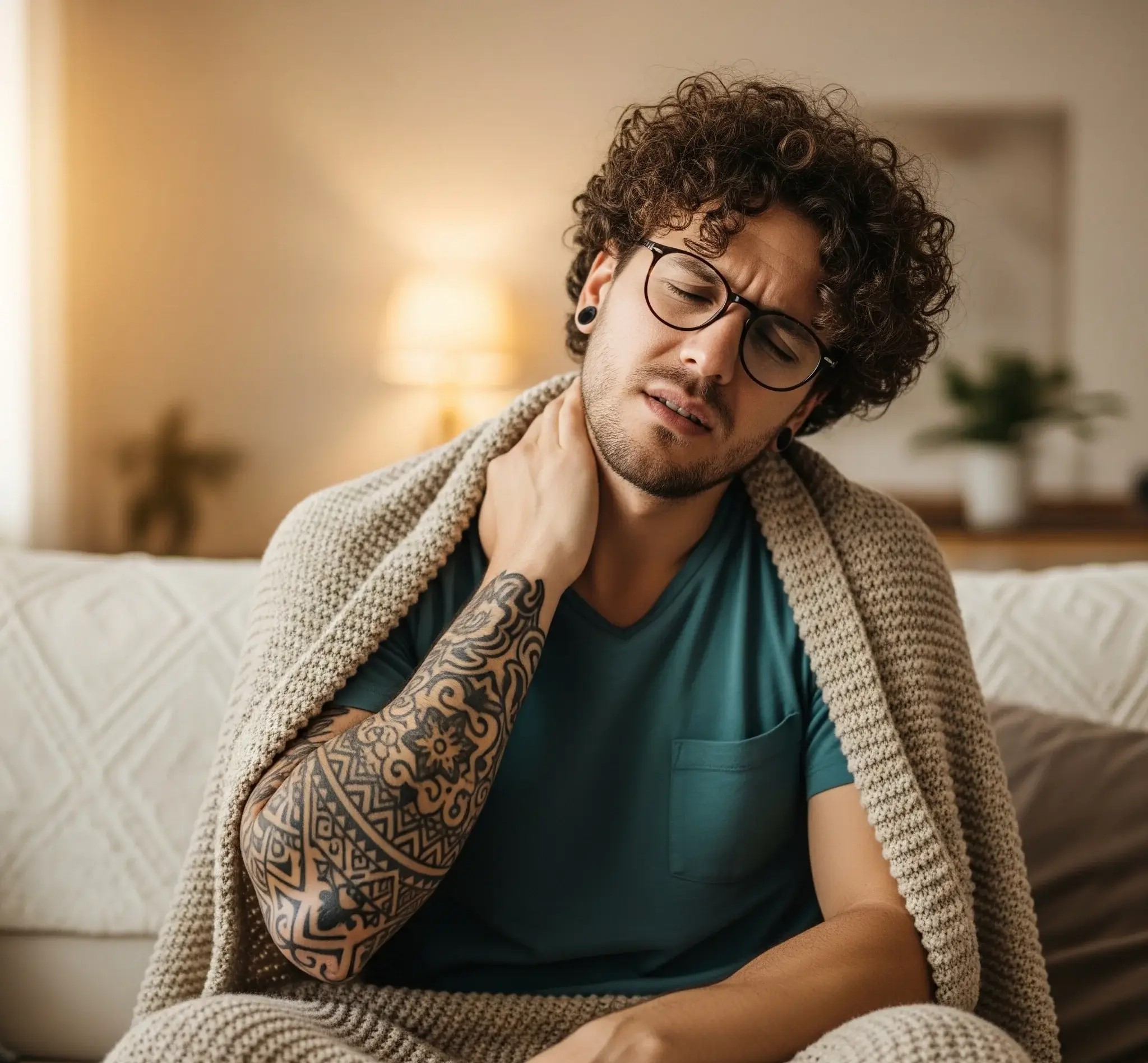Getting a new tattoo is exciting, but some people experience unexpected symptoms afterward that feel a lot like the flu.
Known as “tattoo flu,” this temporary condition can catch many off guard. While it’s usually not serious, understanding its signs and how to prevent it can help you stay comfortable and heal properly.
This guide covers everything you need to know—from symptoms to smart prevention tips.
What Is Tattoo Flu And Why Does It Happen?
Tattoo flu is not an official medical diagnosis, but many people experience flu-like symptoms within 24 to 48 hours after getting inked.
It’s your body’s immune response to trauma from the tattoo needle.
Since your skin is essentially injured during tattooing, your immune system jumps in to repair it—and that can lead to temporary side effects that mimic the flu.
The larger or more detailed the tattoo, the more likely you are to feel these effects.
Some people may not experience tattoo flu at all, while others—especially with sensitive immune systems—might feel drained for a couple of days.
Common Symptoms Of Tattoo Flu To Watch For
Here are the most common signs that you may have tattoo flu:
- Mild to moderate fever
- Chills or shivering
- Fatigue or extreme tiredness
- Body aches or joint pain
- Headache
- Swollen lymph nodes
- General discomfort around the tattoo area
These symptoms can start a few hours after the session and may last a day or two. If symptoms are severe or don’t go away, it’s important to check with a doctor.

How Long Do Tattoo Flu Symptoms Usually Last?
Most tattoo flu symptoms are short-lived. For most people:
- Symptoms begin within 6 to 24 hours after the tattoo session
- They usually last 1 to 3 days
- Mild fatigue may linger for a little longer in some cases
If symptoms last more than 3 days or get worse, it could be something other than tattoo flu, such as an infection or allergic reaction.
Is Tattoo Flu Normal After Getting Inked?
Yes, tattoo flu is fairly common and usually nothing to worry about. It’s simply your immune system doing its job. Some people compare it to how they feel after a vaccine or intense workout—sluggish, sore, and needing rest.
It tends to be more common if:
- You got a large tattoo
- The session lasted several hours
- You have a low pain tolerance
- Your immune system was already a bit weak or run-down
What Causes Tattoo Flu: Main Triggers Explained
The main triggers behind tattoo flu include:
- Immune System Activation: The body responds to the tattoo as if it’s an injury, creating inflammation and flu-like symptoms.
- Stress on the Body: Long tattoo sessions can physically exhaust you.
- Pain Response: Intense or prolonged pain during the session can cause hormonal shifts, including a spike in cortisol.
- Ink Sensitivity: In rare cases, your body may react to certain pigments or ingredients in the tattoo ink.
Difference Between Tattoo Flu And Infection
It’s important to know the difference between harmless tattoo flu and a serious infection. Here’s a comparison:
| Symptom | Tattoo Flu | Tattoo Infection |
|---|---|---|
| Fever | Mild, short-lived | High, persistent |
| Swelling | Slight around tattoo | Spreading or hard swelling |
| Pain | General body aches | Sharp pain at tattoo site |
| Redness | Light and fades | Spreading redness with heat |
| Pus or odor | No | Yes – could signal infection |
If you’re unsure, always consult a medical professional.
Easy Home Remedies For Tattoo Flu Relief
You can manage most tattoo flu symptoms at home using basic care. Here are helpful tips:
- Get plenty of rest: Let your body heal and don’t push yourself too hard.
- Stay hydrated: Water helps flush toxins and supports immune function.
- Eat nutritious food: Focus on immune-boosting meals with fruits, veggies, and lean protein.
- Use a cold compress: If you have a mild fever, it may help bring it down.
- Take over-the-counter medicine: Paracetamol or ibuprofen can ease fever and body aches (ask your doctor first if unsure).
When To See A Doctor For Tattoo Flu Symptoms?
While tattoo flu is usually harmless, see a doctor if:
- Your fever goes above 101.5°F (38.6°C)
- Symptoms last longer than 3 days
- The tattoo site becomes red, oozes pus, or feels very hot
- You experience dizziness or trouble breathing
Trust your instincts—if something doesn’t feel right, it’s better to get it checked.

Tips To Prevent Tattoo Flu Before And After A Tattoo
Want to avoid tattoo flu? These simple steps can help lower your risk:
✅ Before Your Tattoo Session:
- Get plenty of sleep the night before
- Eat a healthy meal before your appointment
- Avoid alcohol or caffeine, which can dehydrate you
- Take a multivitamin (if approved by your doctor) to support immunity
✅ After Your Tattoo Session:
- Follow your artist’s aftercare instructions
- Stay well-hydrated and eat nourishing foods
- Avoid overexertion—give your body time to rest
- Keep the tattoo clean and dry to avoid infection
How To Boost Your Immune System Before A Tattoo Session?
Supporting your immune system before a tattoo can reduce your chances of post-tattoo illness. Here’s how:
- Start taking vitamin C or elderberry supplements a few days before (check with your doctor)
- Eat antioxidant-rich foods like berries, leafy greens, and citrus fruits
- Avoid junk food and processed sugar
- Cut back on smoking or alcohol, both of which can slow recovery
- Stay hydrated in the days leading up to the session
Can Tattoo Flu Be Avoided With Aftercare?
Good aftercare won’t guarantee flu prevention, but it plays a big role in reducing your body’s stress. Think of aftercare as part of your full recovery plan.
Keeping the skin clean, moisturized, and protected will lower inflammation—and that helps your whole system bounce back faster.
Tattoo Flu In Sensitive Skin: Extra Precautions To Take
If you already have sensitive skin or a reactive immune system, you’ll want to take some extra care:
- Choose a reputable tattoo artist who uses high-quality inks
- Ask for a patch test if you’re worried about ink sensitivity
- Take shorter tattoo sessions instead of one long sitting
- Use hypoallergenic moisturizers during healing
- Alert your artist if you have autoimmune conditions or allergies beforehand
Final Thoughts
Tattoo flu might sound scary, but it’s usually a harmless and short-lived reaction to the body’s healing process.
Knowing what to expect, how to treat it, and how to prevent it can make the whole tattoo experience much smoother.
Always listen to your body, give it the care it needs, and reach out to a doctor if something feels off. Your tattoo is a work of art—but taking care of yourself is just as important.
Read More:
- 12 Bold Sagittarius Tattoo Ideas With Deep Meaning
- Can You Get A Tattoo If You Have Sensitive Skin? A Full Guide
- 13 Taurus Tattoo Ideas That Show Off Your Zodiac Power
- Top 12 Ghost Face Tattoo Designs To Try Now
- 10 Meaningful Kids Tattoos For Moms That Melt Your Heart
- Top 13 Pumpkin Tattoo Ideas For Halloween Lovers
- 12 Freddy Krueger Tattoo Ideas Every Horror Fan Will Love
- Top 12 American Flag Tattoo Designs To Inspire You
- 10 Stunning June Flower Tattoos With Meaning
- 13 Meaningful Blue Butterfly Tattoo Ideas For Women
- 12 Meaningful Blue Heron Tattoo Ideas You’ll Instantly Love
- 12 Teacher Tattoo Ideas That Celebrate Your Calling
- 12 Small Lily Tattoo Ideas That Are Pure And Beautiful
- 12 Crab Tattoo Ideas For Women That Are Cute And Bold
- 15 Stunning Back Leg Tattoos Women Are Loving Now
- 12 Stunning Bird Tattoos For Women That Are Full Of Meaning
